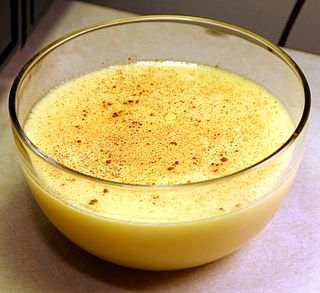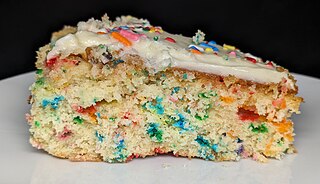Bumpy cake was created by Sanders Confectionery, of Detroit, Michigan, in the early 1900s [1] and was known as "The Sanders Devil's Food Buttercream Cake" when it was first introduced. [2] It is made of chocolate devil's food cake that is topped with rich buttercream bumps, and then draped in a chocolate ganache. Now more than a century old, this is a classic confection. [3]
Sanders Confectionery makes the original trademarked Bumpy Cake, but other companies have attempted to use this trademarked name many times during the cake's 100-year-plus history.
In recipes adapted for the home kitchen it can be made by piping the buttercream frosting in thick half-inch diameter strips, about one inch apart. It is placed in the freezer for around two minutes to set the butter cream. The warm fudge frosting is poured over the cake to cover the bumps of buttercream. The frosting sets in the fridge. [4]
The cake is typically baked in an 8-inch-square pan lined with parchment. The first step in preparing the batter is to cream butter, sugar and oil, then eggs and egg whites are added. The dry ingredients—cake flour, cocoa powder, espresso powder, baking powder and salt—are prepared in a separate bowl and are then gradually added to the creamed mixture, alternating with buttermilk.

Cake is a flour confection made from flour, sugar, and other ingredients and is usually baked. In their oldest forms, cakes were modifications of bread, but cakes now cover a wide range of preparations that can be simple or elaborate and which share features with desserts such as pastries, meringues, custards, and pies.

Custard is a variety of culinary preparations based on sweetened milk, cheese, or cream cooked with egg or egg yolk to thicken it, and sometimes also flour, corn starch, or gelatin. Depending on the recipe, custard may vary in consistency from a thin pouring sauce to the thick pastry cream used to fill éclairs. The most common custards are used in custard desserts or dessert sauces and typically include sugar and vanilla; however, savory custards are also found, e.g., in quiche.

Devil's food cake is a moist, rich chocolate layer cake.

Icing, or frosting, is a sweet, often creamy glaze made of sugar with a liquid, such as water or milk, that is often enriched with ingredients like butter, egg whites, cream cheese, or flavorings. It is used to coat or decorate baked goods, such as cakes. When it is used between layers of cake it is known as a filling.

Red velvet cake is traditionally a red, crimson, or scarlet-colored layer cake, layered with ermine icing. Traditional recipes do not use food coloring, with the red color possibly due to non-Dutched, anthocyanin-rich cocoa, and possibly due to the usage of brown sugar, formerly called red sugar.

German chocolate cake, originally German's chocolate cake, is a layered chocolate cake filled and topped with a coconut-pecan frosting. Originating in the United States, it was named after English-American chocolate maker Samuel German, who developed a formulation of dark baking chocolate that came to be used in the cake recipe. Sweet baking chocolate is traditionally used for the cake's flavor, but few recipes call for it today. The filling and/or topping is a custard made with egg yolks and evaporated milk; once the custard is cooked, coconut and pecans are stirred in. Occasionally, a chocolate frosting is spread on the sides of the cake and piped around the circumference of the layers to hold in the filling. Maraschino cherries are occasionally added as a garnish.

A layer cake or sandwich cake is a cake consisting of multiple stacked sheets of cake, held together by frosting or another type of filling, such as jam or other preserves. Most cake recipes can be adapted for layer cakes; butter cakes and sponge cakes are common choices. Frequently, the cake is covered with icing, but sometimes, the sides are left undecorated, so that the filling and the number of layers are visible.

Entenmann's is an American company that manufactures baked goods and delivers them throughout the United States to supermarkets and other retailers for public sales. Often, they are known to have display cases at the end of store aisles. The company offers dessert, cup, loaf, and crumb cakes, and donuts, cookies, pies, cereal bars, muffins, Danish pastries, and among other baked goods, buns. In the past several years, they have added designer coffee flavors along with scented candles to their product line in an effort to broaden its appeal.

A butter cake is a cake in which one of the main ingredients is butter. Butter cake is baked with basic ingredients: butter, sugar, eggs, flour, and leavening agents such as baking powder or baking soda. It is considered one of the quintessential cakes in American baking. Butter cake originated from the English pound cake, which traditionally used equal amounts of butter, flour, sugar, and eggs to bake a heavy, rich cake.

Chocolate cake or chocolate gâteau is a cake flavored with melted chocolate, cocoa powder, or both. It can also have other ingredients such as fudge, vanilla creme, and other sweeteners.

A génoise, also known as Genoese cake or Genovese cake, is a French sponge cake named after the city of Genoa and associated with French cuisine. It was created by François Massialot in the late 17th century. Instead of using chemical leavening, air is suspended in the batter during mixing to provide volume.

Lane cake, also known as prize cake or Alabama Lane cake, is a bourbon-laced baked cake traditional in the American South. It was invented or popularized by Emma Rylander Lane (1856-1904), a native and long-time resident of Americus, Georgia, who developed the recipe while living in Clayton, Alabama, in the 1890s. She published the original recipe in Some Good Things to Eat (1898). Her original recipe included 8 egg whites, 1 cup butter, 1 cup sweet milk, 2 cups sifted sugar, 3 ¼ cups sifted flour, 2 teaspoons baking powder, 1 tablespoon vanilla and called for the layers to be baked in pie tins lined with ungreased brown paper rather than in cake pans. The filling called for 8 egg yolks, 1 cup of sugar, 1/2 cup butter, 1 cup seeded raisins, 1 wine-glass of whiskey or brandy, and 1 teaspoon vanilla.

Buttercream, also referred to as butter icing or butter frosting, is used for either filling, coating or decorating cakes. The main ingredients are butter and some type of sugar.
Sanders Chocolates is an American brand of chocolates that was founded by Fred Sanders on June 17, 1875. According to company history, by the mid-20th century, the company operated 57 retail stores in the Great Lakes region, featuring counter service offering candy, fudge toppings, baked goods, light lunches and an assortment of desserts. Sanders is known for its bumpy cake and hot fudge cream puffs.

Cake decorating is the art of decorating a cake for special occasions such as birthdays, weddings, baby showers, national or religious holidays, or as a promotional item.

Flourless chocolate cake is a dense cake made from an aerated chocolate custard. The origin of the cake is not clear. The dessert contains no gluten, which makes it acceptable for those with celiac disease, gluten-free diets, and during religious holidays in which gluten and grains are not permitted.
The following outline is provided as an overview of and topical guide to chocolate:

Sponge cake is a light cake made with eggs, flour and sugar, sometimes leavened with baking powder. Some sponge cakes do not contain egg yolks, like angel food cake, but most of them do. Sponge cakes, leavened with beaten eggs, originated during the Renaissance, possibly in Spain. The sponge cake is thought to be one of the first non-yeasted cakes, and the earliest attested sponge cake recipe in English is found in a book by the English poet Gervase Markham, The English Huswife, Containing the Inward and Outward Virtues Which Ought to Be in a Complete Woman (1615). Still, the cake was much more like a cracker: thin and crispy. Sponge cakes became the cake recognised today when bakers started using beaten eggs as a rising agent in the mid-18th century. The Victorian creation of baking powder by English food manufacturer Alfred Bird in 1843 allowed the addition of butter to the traditional sponge recipe, resulting in the creation of the Victoria sponge. Cakes are available in many flavours and have many recipes as well. Sponge cakes have become snack cakes via the Twinkie.

Confetti cake is a type of cake that has rainbow colored sprinkles baked into the batter. It is called confetti cake because when baked, the rainbow sprinkles melt into dots of bright color that resemble confetti. Typically the batter is either white, golden, or yellow to allow for a better visual effect; but chocolate, devil’s food, and strawberry cake variations also exist. The cake generally consists of flour, butter, baking powder, salt, sugar, vegetable oil, eggs, vanilla extract, milk, and rainbow colored sprinkles. The cake normally has a frosting made of butter, salt, powdered sugar, vanilla extract, and milk.